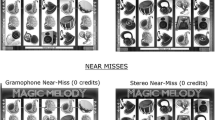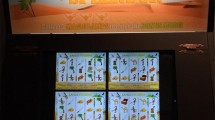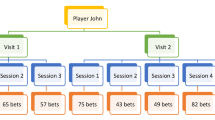Abstract
The present study examined the degree to which slot machine near-miss trials, or trials that displayed 2 of 3 winning symbols on the payoff line, affected response times and win estimations of 12 recreational slot machine players. Participants played a commercial slot machine in a casino-like laboratory for course extra-credit points. Videotaped sessions were later coded to assess trial types and participant response latencies and win estimations for each participant. Results show that all 12 participants emitted verbalizations suggesting near-miss trials were of a higher approximation to a win than non-near-miss losing trials. Of the 12 participants 8 also demonstrated higher response latencies following losing trials than following winning trials. Variations across participants’ response latencies were attributed to the presence of and response to near miss trials. The implications of the near-miss on game preference, resistance to extinction, and the development of a behavioral treatment for pathological gamblers are discussed.
Similar content being viewed by others
References
AMERICAN PSYCHIATRIC ASSOCIATION. (1994). Diagnostic and statistical manual of mental disorders (4th ed.). Washington, DC: Author.
ATOR, N. A. (1999). Statistical inference in behavior analysis: Environmental determinants? The Behavior Analyst, 22, 93–98.
BARON, A. (1999). Statistical inference in behavior analysis: Friend or foe? The Behavior Analyst, 22, 83–86.
BLASZCZYNSKI, A. P., & MCCONAGHY, N. (1994). Criminal offenses in Gamblers Anonymous and hospital treated pathological gamblers. Journal of Gambling Studies, 10, 99–127.
BROWN, R. I. F. (1986). Arousal and sensation-seeking components in the general explanation of gambling and gambling addictions. International Journal of the Addictions, 21, 1001–1016.
BUJOLD, A., LADOUCEUR, R., SYLVAIN, C., & BOISVERT, J. M. (1994). Treatment of pathological gamblers: An experimental study. Journal of Behavior Therapy and Experimental Psychiatry, 25, 275–282.
CROSBIE, J. (1999). Statistical inference in behavior analysis: Useful friend. The Behavior Analyst, 22, 105–108.
DELFABBRO, P. H., & WINEFIELD, A. H. (1999). Poker-machine gambling: Analysis of within-session characteristics. British Journal of Psychology, 90, 425–439.
DIXON, M. R. (2000). Manipulating the “Illusion of Control”: Variations in risk-taking as a function of perceived control over chance outcomes. The Psychological Record, 50, 705–720.
DIXON, M. R., HAYES, L J., & ZBAN, I. (2000). Examining the roles of rule following, reinforcement, and preexperimental histories on risk-taking behavior. The Psychological Record, 50, 687–704.
DIXON, M. R., & SCHREIBER, J. (2002). Utilizing a computerized video poker simulation for the collection of experimental data on gambling behavior. The Psychological Record, 52, 417–428.
GHEZZI, P., LYONS, C., & DIXON, M. R. (2000). Gambling from a socioeconomic perspective. In W. K. Bickel & R. E. Vuchinich (Eds.), Reframing health behavior change with behavioral economics. New York: Erlbaum.
GRIFFITHS, M. R. (1999). The psychology of the near-miss (revisited): A comment on Delfabbro & Winefield (1999). British Journal of Psychology, 90, 441–445.
HAYES, S. C. (1986). The case of the silent dog — verbal reports and the analysis of rules. A review of Ericsson and Simon’s Protocol Analysis: Verbal Reports as Data. Journal of the Experimental Analysis of Behavior, 45, 351–363.
HINELINE, R. N. (1977). Negative reinforcement and avoidance. In W. K Honig & J. E. R. Staddon (Eds.), Handbook of operant behavior. New York: Prentice Hall.
KANTOR, J. R. (1924). Principles of psychology. New York: Alfred A. Knopf.
KNAPP, T. J. (1998). Behaviorism and public policy: B. F. Skinner’s views on gambling. Behavior and Social Issues, 7, 129–139.
LADOUCEUR, R., BOISVERT, J., PEPIN, M., LORANGER, M., & SYLVAIN, C. (1994). Social costs of pathological gambling. Journal of Gambling Studies, 10, 399–409.
LESIEUR, H. R., & BLUME, S. B. (1987). The South Oaks Gambling Screen (Sogs): A new instrument for the identification of pathological gamblers. American Journal of Psychiatry, 144, 1184–1188.
LYONS, C. A., & GHEZZI, P. M. (1995). Wagering on a large scale: Relationships between public gambling and game manipulations in two state lotteries. Journal of Applied Behavior Analysis, 28, 127–137.
MACE, F. C., & WACKER, D. P. (1994). Toward greater integration of basic and applied behavioral research: An introduction. Journal of Applied Behavior Analysis, 27, 569–574.
MACLIN, O. H., Dixon, M. R., & HAYES, L. J. (1999). A computerized slot machine simulation to investigate the variables involved in gambling behavior. Behavior Research Methods, Instruments, and Computers, 31(4), 731–735.
MCGLYNN, R. D., & ROSE, M. P. (1998). Assessment of anxiety and fear. In A. S. Bellack & M. Hersen (Eds.), Behavioral assessment. New York: Allyn and Bacon.
MICHAEL, J. (1982). Distinguishing between discriminate and motivational functions of stimuli. Journal of the Experimental Analysis of Behavior, 37, 149–155.
NATIONAL GAMBLING IMPACT STUDY COMMISSION (1999). Ngisc Final Report. Retrieved January 30, 2004, from http://www.ncfpc.org/specialngisc.html
NATIONAL RESEARCH COUNCIL. (1999, April 1). Pathological gambling: A critical review, p. Exec-2
NEVADA STATE GAMING CONTROL BOARD. (1997). Gaming revenue report (Vol. 4). Carson City, NY: Author.
PERONE, M. (1999). Statistical inference in behavior analysis: Experimental control is better. The Behavior Analyst, 22, 109–116.
PHILLIPS, D. P., WELTY, W. R., & SMITH, M. M. (1997). Elevated suicide levels associated with legalized gambling. Suicide and Life-Threatening Behavior, 27, 373–378.
REID, R. L. (1986). The psychology of the near miss. Journal of Gambling Behaviour, 2, 32–39.
SCHREIBER, J., & DIXON, M. R. (2001). Temporal characteristics of behavior on random-ratio schedules observed during slot machine play. Psychological Reports, 89, 67–72.
SKINNER, B. F. (1953). Science and human behavior. New York: Appleton-Century-Crofts.
STROMER, R. (2000). Integrating basic and applied research and the utility of Lattai and Perone’s Handbook of research methods in human operant behavior. Journal of Applied Behavior Analysis, 33, 119–136.
WACKER, D. P. (1996). Behavior analysis research in Jaba: A need for studies that bridge basic and applied research. Experimental Analysis of Human Behavior Bulletin, 14, 11–14.
Author information
Authors and Affiliations
Additional information
A Faculty Research/Creative Grant awarded to Mark Dixon by Southern Illinois University in part supported this research. We thank Daniel Fienup for assistance with participant recruitment and data collection. We also thank Dr. Thomas Critchfield for his constructive comments on an earlier version of this manuscript.
Rights and permissions
About this article
Cite this article
Dixon, M.R., Schreiber, J.E. Near-Miss Effects on Response Latencies and Win Estimations of Slot Machine Players. Psychol Rec 54, 335–348 (2004). https://doi.org/10.1007/BF03395477
Published:
Issue Date:
DOI: https://doi.org/10.1007/BF03395477




